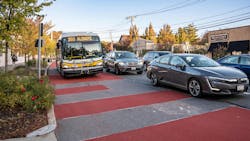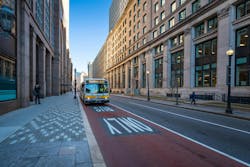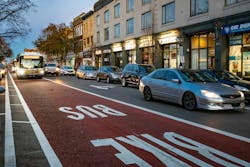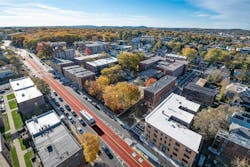MBTA Creating A Better Experience for Passengers with Bus Network Improvements
With more than 300,000 people per weekday taking a Massachusetts Bay Area Transportation Authority (MBTA) bus for work or leisure activities, the MBTA is one of the most heavily populated transit systems in the U.S., with ridership growing by approximately 12% from January 2024 through January 2025 across all modes, according to the MBTA’s Performance Metrics Database.
Part of the reason for the growth in transit ridership is due to MBTA overhauling its bus network, known as the Better Bus Project. MBTA first launched the program in 2018, with the goal to improve service, install bus lane infrastructure and modernize transit facilities as buses account for 40% of the agency’s ridership.
Improving the bus experience
According to MBTA Director of Transit Priority Alex Hallowell, the Better Bus Project is the first project the MBTA has launched that puts specific funding and effort exclusively towards buses. Hallowell notes the project has four key initiatives:
- Make the bus an easy choice for riders.
- Make buses go when and where riders need them to go.
- Make riding the bus a reliable experience.
- Make bus stops comfortable, accessible and safe.
As part of the Better Bus Project, the MBTA has begun to redesign its bus network, with the goal of offering more frequent service in heavily populated neighborhoods and providing all day service. In December 2024, the agency launched Phase 1 of the redesign, which included six route changes in Chelsea, Everett, Revere, Malden, Somerville, Cambridge, Allston, Brighton and East Boston, as well as new connections to the Red, Orange, Green and Blue rail lines and Boston Logan International Airport.
Hallowell notes improving frequency throughout MBTA service areas was the first step of the project.
“We’ve done a lot of service promotions [throughout the Boston area],” Hallowell noted. “Service is now operating from 5:00 a.m. to 1:00 a.m., seven days a week, at least every 15 minutes, and that makes bus transit in particular just a much easier choice.”
The agency does not have a set timeline for a Phase 2 of the project and says routes will continue to be adjusted through seasonal service adjustments. According to the agency, a new phase will be introduced when needed.
Transit Priority Vision
MBTA’s Transit Priority Vision is part of the Better Bus Project that aims to install infrastructure and technology improvements to speed up bus service. It details the most congested areas in which the MBTA operates by what the agency describes as “persons hours of delay.” This pinpoints exactly where riders are stuck in traffic using a CAD/AVL system that tracks buses to develop a dataset, showing the agency how travel times change over the course of time during the week.
In a statement to Mass Transit magazine, MBTA’s Deputy Press Secretary Lisa Battiston said, “We generally get a sense of what good performance looks like by looking at early morning/late night service when there is relatively little traffic delaying our buses. Comparing different periods of the day against that baseline demonstrates how much we expect traffic to impact service. We pair this delay factor with our passenger counts, weighing the delay of the bus service by the number of people impacted. The corridors with the highest passenger delay are what we used to generate our Priority Vision.”
The 26 most congested areas identified by the Transit Priority Vision represent 80% of the agency’s ridership, but the areas only cover between 10 and 15% of the MBTA service area.
To help address these congested areas, the agency has a Bus Priority Toolkit that outlines available Transit Priority Vision designs and technological tools. According to the agency, the most common Transit Priority Vision options are:
- Dedicated bus lanes
- Shared bus/bike lanes
- Center-running bus lanes
- Transit signal priority (TSP)
- Queue jumps
- Fixed guideways
MBTA has started implementing bus lanes as part of the Transit Priority Vision project at the 2nd Street project in Everett and Chelsea in the westbound direction as part of the service changes that took place in December 2024.
Traffic Management Center
Transit Priority Vision is monitored at the Traffic Management Center, which is managed by the Boston Transportation Department (BTD) and enables more accurate detection and response to bus timing needs with traffic signal technology.
At the beginning of this year, MBTA and the city announced their intentions to upgrade the Traffic Management Center to integrate MBTA bus locations into real-time traffic signal adjustments. At the time of the announcement, MBTA attributed the upgrade to the Traffic Management Center as an important piece to speed up transit-related traffic delays; although the traffic signal software had a positive impact, up to 50 percent of transit delays still consisted of waiting at red lights in signalized intersections.
TSP
MBTA and the city worked with BTD’s traffic signal vendor, Control Technologies, Inc to update the Traffic Management Center to help speed up bus service delayed by red lights. The company LYT deployed its machine-learning TSP technology to track and predict bus locations. The updates took place during 2023 and wrapped up in early 2024.
According to BTD Public Information Officer Nick Osbourne, the MBTA and the city of Boston have been running a three-intersection, one-year proof-of-concept test since July 2024 to make sure the TSP technology would function properly. Osbourne notes the test is along Brighton Avenue at the intersections of Allston Street, Harvard Avenue and Linden Street, improving reliability on the 57 and 66 bus routes. The routes have approximately 15,000 daily riders each, and both are in the top 10 for highest ridership throughout the MBTA service area.
Osbourne says the testing phase has had some setbacks.
“The server needed to be upgraded to support the new technology; resolving communications issues between the MBTA and the city's systems and addressing compatibility concerns to ensure the upgraded TSP could integrate smoothly with both existing traffic signal infrastructure and MBTA bus systems,” Osbourne noted. “These technical hurdles had to be worked through collaboratively to enable a stable and effective deployment.”
According to Osbourne, since the server upgrades, buses traveling through the corridor spent 21% less time waiting at red lights on average and arrived at a green light 5% more often, which has resulted in buses saving an average of 16 seconds per arrival time for a combined total of 110 minutes saved each weekday.
Bus lanes and que jumps
The agency has begun installing bus lanes throughout many cities in the area, including Cambridge, Somerville, Chelsea, Everett and Brookline. Along with the bus lanes, the MBTA has also installed queue jumps, which allow buses to use dedicated lanes to dodge rows of traffic and lights on roads, making the bus a safer and faster mode of transportation than a car.
“When we would be having discussions within our team about transit, our goal was to create a space for people,” Hallowell noted. “We said, ‘Let’s look at this not as vehicle throughput, but as moving people, and the best way to move people through these corridors is creating a protected space for buses.’”
According to Hallowell, the queue jumps don’t take up a lot of space on the road, approximately a couple parking spaces. The agency has also deployed bus-only peak hour lanes in some areas to speed up service. Hallowell says they are mostly used during rush hour.
“What’s great about peak hour lanes is we can take some of that area for cars and give it to a bus lane, but only during a peak period, and then that lane reverts to other needs for the community during the hours buses don’t need them. We can make those projects more effective and more politically viable when there’s a lot of competing needs on the roadway,” Hallowell said.
Future projects
Hallowell says that by 2030, MBTA is hoping to complete many Transit Priority Vision projects that are currently under construction. For instance, the Tremont/Columbus Project will extend the existing bus lane on Columbus Avenue a mile north, giving better transit access and reliability for 220,000 daily riders.
MBTA and the city are also working together on the Blue Hill Avenue Transportation Action Plan, which will redesign the corridor between Warren Street in Grove Hall and River Street in Mattapan Square. The redesign aims to save riders up to 10 minutes a day.
All the changes that have already taken place have affected Hallowell’s personal life.
“My service went from maybe every 20ish minutes during the week and maybe every half an hour, even 45 minutes on Sundays to every 15 minutes seven days a week,” Hallowell noted.
About the Author
Brandon Lewis
Associate Editor
Brandon Lewis is a recent graduate of Kent State University with a bachelor’s degree in journalism. Lewis is a former freelance editorial assistant at Vehicle Service Pros in Endeavor Business Media’s Vehicle Repair Group. Lewis brings his knowledge of web managing, copyediting and SEO practices to Mass Transit Magazine as an associate editor. He is also a co-host of the Infrastructure Technology Podcast.




